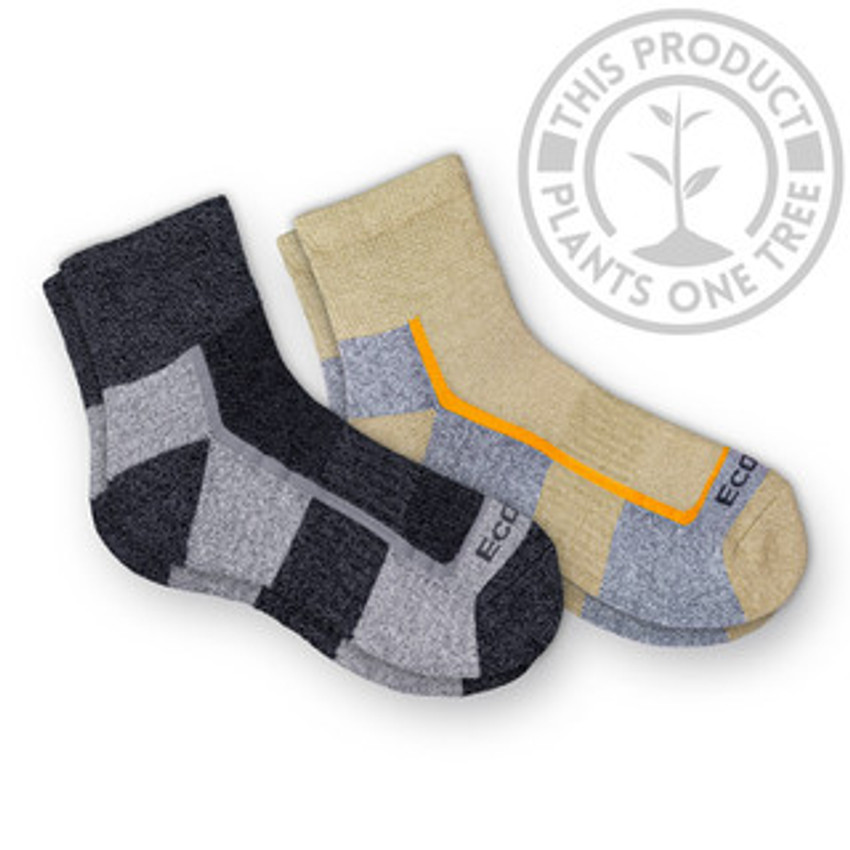Beat Muscle Soreness in Legs: Tips & Tricks
Posted by EcoSox on Apr 26th 2024
Beat Muscle Soreness in Legs: Tips & Tricks
Muscle soreness in the legs is an all-too-familiar feeling. Whether you're a seasoned athlete pushing your limits or simply getting back into an exercise routine, those achy, stiff legs can throw a wrench in your day. While muscle soreness means your body is adapting, it doesn't mean you have to suffer through it.
Leg muscle soreness can be caused by a simple workout or signal something more serious. Let's explore the reasons behind leg soreness and discover ways to get you back on your feet comfortably.
What Causes Muscle Soreness in Legs?
Muscle soreness in the legs, especially a day or two after exercise, is often a sign of Delayed Onset Muscle Soreness (DOMS). DOMS happens when microscopic tears occur in your muscle fibers during intense or unfamiliar workouts. While this damage sounds alarming, it's part of building muscle strength. As your muscles heal, they get stronger and better able to handle that workload in the future.
However, DOMS isn't the only culprit behind leg soreness. Here's a breakdown of the most common causes:
Overuse and Strain
Pushing your muscles too far, too fast, especially with repetitive motions, leads to strain and inflammation.
New Workouts
Switching up your exercise routine or suddenly increasing intensity shocks your muscles, leading to soreness.
Muscle Imbalance
If certain leg muscles are significantly weaker than others, they can become overworked, leading to pain.
Underlying Conditions
While less common, conditions like fibromyalgia, peripheral artery disease, and certain medication side effects can contribute to chronic muscle pain. If your soreness is severe or doesn't fade with rest, consult a doctor.
Lifestyle Changes To Reduce Muscle Soreness in Legs
Muscle soreness might be unavoidable, but these lifestyle adjustments can minimize discomfort and accelerate recovery.
Warm-Up & Cool Down
Do a proper warm-up (5-10 minutes) before exercise. Light cardio and dynamic stretches like lunges increase blood flow to muscles, preparing them for exertion and reducing injury risk.
Similarly, a cool-down (5-10 minutes) with static stretches (holding stretches for 20-30 seconds) helps your muscles relax and begin the recovery process.
Stay Hydrated
Our bodies are mostly water, and muscles are no exception. Dehydration can worsen muscle soreness and hinder recovery. Drink plenty of water throughout the day, especially before, during, and after exercise. Listen to your thirst cues and adjust your water intake based on activity level and climate.
Nutrition & Supplements
Eating a balanced diet rich in protein supplies the building blocks your muscles need to repair and rebuild after exercise. Aim for protein sources like lean meats, fish, eggs, legumes, and nuts at each meal. You can also try anti-inflammatory supplements like turmeric or fish oil. However, you need to consult your doctor before starting any new supplements, especially if you have pre-existing health conditions or take medications.
Rest & Recovery
This might sound obvious, but sufficient sleep is important for muscle growth and repair. Prioritize getting 7-8 hours of quality sleep each night.
Additionally, schedule rest days into your workout routine. Your muscles need time to rebuild after exercise, so avoid overtraining. Listen to your body. If you're excessively sore, take an extra rest day.
Try Compression Socks
Compression socks, like EcoSox, can improve circulation and reduce muscle soreness after exercise. The gentle pressure applied by these socks may help flush out lactic acid, a byproduct of exercise that contributes to muscle fatigue and soreness.
EcoSox offers mild compression (8-15 mmHg), ideal for recovery, and their bamboo or merino wool blends keep your legs comfortable throughout the day.
Tips for Immediate Leg Pain Relief
When muscle soreness in your legs strikes, you want fast relief. Try these strategies alongside the lifestyle changes discussed above.
1. Apply ice to sore muscles.
Apply ice packs or a bag of frozen vegetables wrapped in a towel to the sore area for 15-20 minutes at a time. Repeat a few times per day. Ice reduces inflammation and numbs pain temporarily.
2. Use heat therapy after inflammation reduces.
Once the initial inflammation subsides (usually after the first 48 hours), use a heating pad or take a warm bath to increase blood flow to the sore muscles, promoting relaxation and healing.
3. Elevate your legs to reduce swelling.
If swelling is present, raise your legs above heart level while resting. Prop them on pillows to help reduce fluid pooling in your legs.
4. Engage in gentle movement to stimulate blood flow.
While rest is important, complete inactivity can make soreness worse. Try light activities like walking or gentle yoga poses to stimulate blood flow and aid recovery.
5. Consider over-the-counter pain relievers
Take non-steroidal anti-inflammatory drugs (NSAIDs) like ibuprofen or naproxen to manage pain and swelling. Consult your pharmacist or doctor if you have concerns or take other medications.
Additional Tips to Manage Muscle Soreness
Alongside the immediate relief strategies, here are some extra ways to help your muscles feel their best.
Foam Rolling
Use a foam roller to massage sore muscles. This self-massage technique can release tension, improve flexibility, and increase blood flow to aid recovery. Look up online tutorials for guidance on proper form.
Professional Massage
If your soreness is persistent or severe, consider getting a massage from a qualified therapist. A sports massage can address specific muscle groups and help break up adhesions that might be contributing to pain.
Stretching
Regular stretching improves your range of motion and makes muscles less prone to injury and soreness. Incorporate static stretching (holding a stretch for 20-30 seconds) into your daily routine, even on non-workout days.
If your muscle soreness is accompanied by fever, severe swelling, or limited mobility, seek medical attention promptly. These could be signs of a more serious injury.
Tired of Sore Legs? Try Compression Socks
Muscle soreness in the legs is a common experience, especially after pushing yourself physically. Remember, it's often a sign that your body is adapting and getting stronger. By understanding the causes and implementing the strategies we've discussed, you can minimize discomfort and maximize your fitness potential.
Adding EcoSox compression socks into your recovery routine can provide additional support, reducing inflammation and helping you feel your best while staying active.

